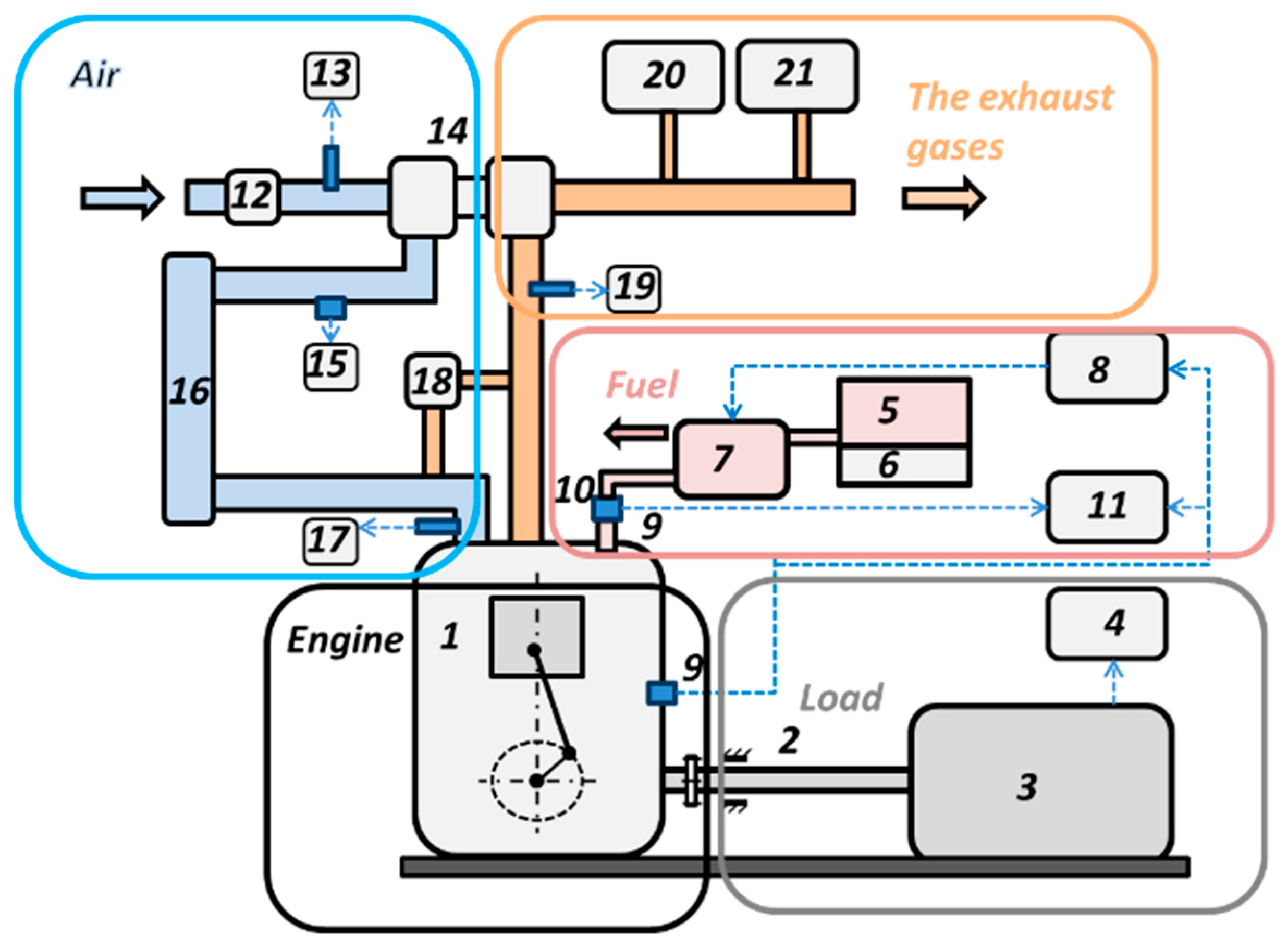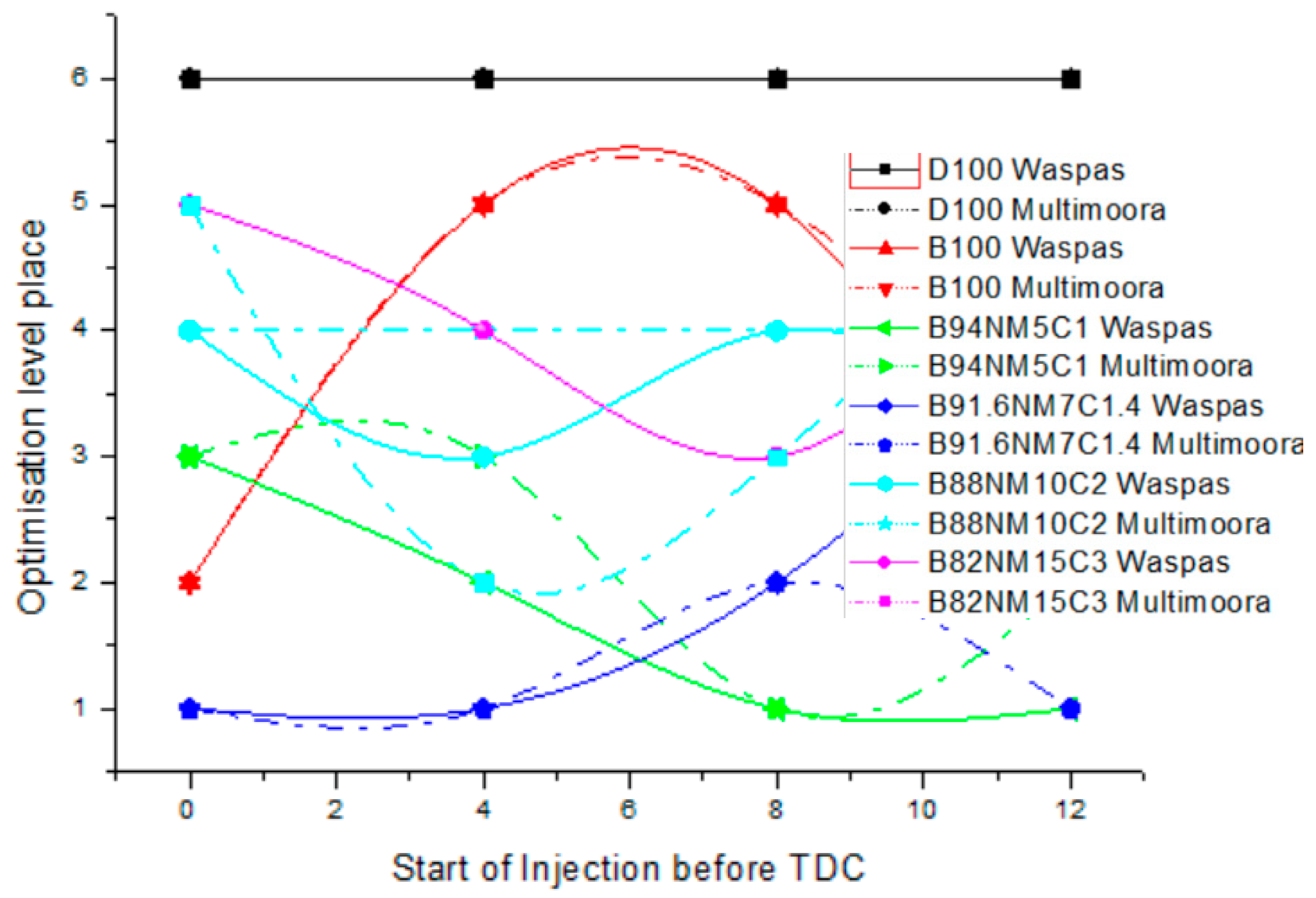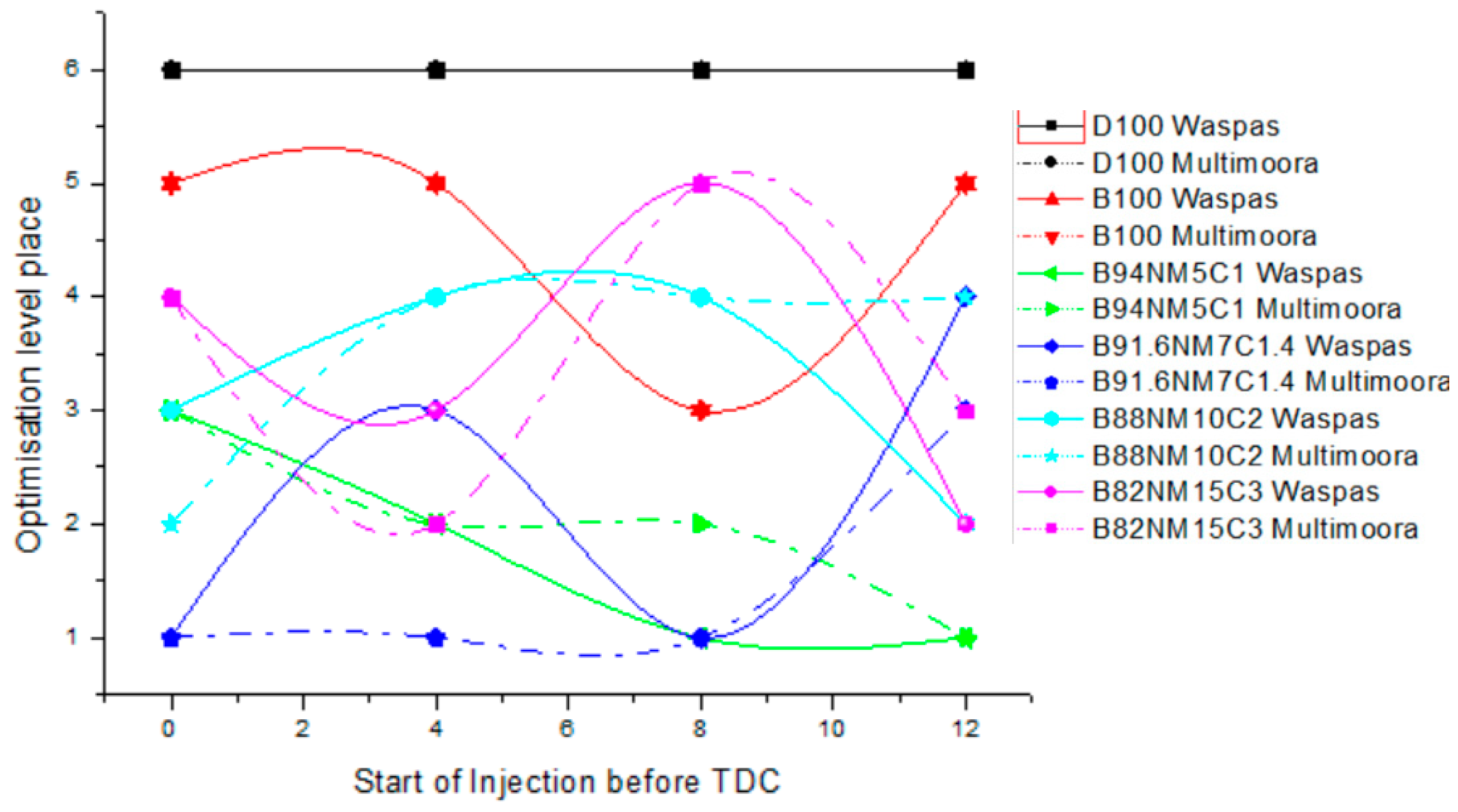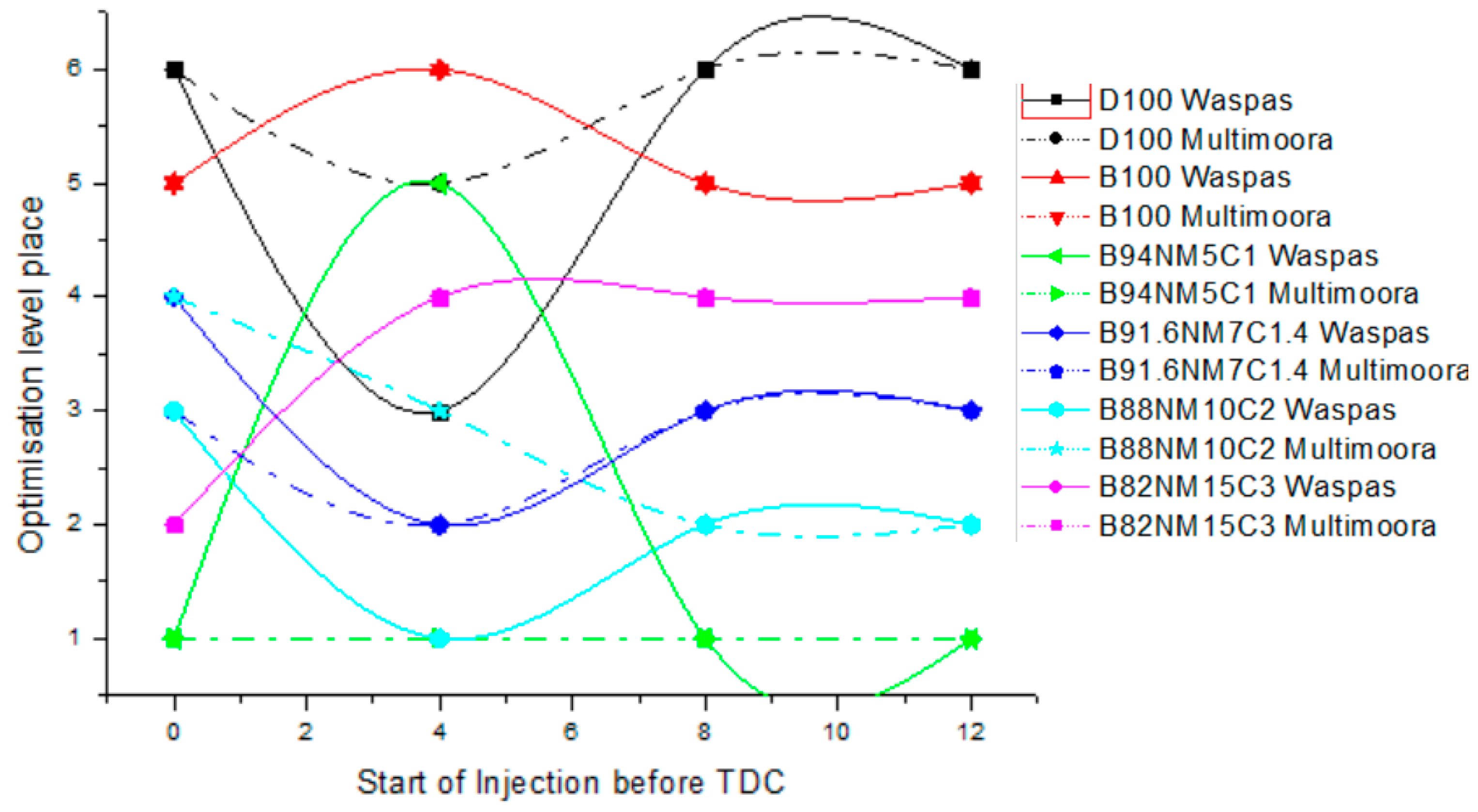1. Introduction
The European Union (EU) directives govern the mandatory increase in the share of biofuels in overall fuel consumption. Currently, this is a crucial political aspect of the assurance of EU energy saving and environmental requirements. According to the EU Directive 2003/30/ EC, member states shall sell 10% of biofuels in 2020 [
1]. The “polluter pays” principle, which was transposed from EU directives to national legislation, is valid throughout the EU [
2]. Both heavy transport and passenger cars [
3] with strict regulation of carbon dioxide (CO
2) emissions [
4] are subject to these requirements. The search for new innovative solutions to reduce pollution in the transport sector is a priority EU direction. These include energy and sustainable environment, as well as transport, logistics, and information and communication technologies [
5]. The EU White Paper sets out the principles for promoting energy saving and eco-friendly transport solutions [
6]. One of these directions could be the usage of different alternative fuels like hydrogen (H) [
7,
8] and biogas [
9,
10], some different mixtures with gasoline [
11,
12], or ethanol [
13].
Biodiesel is now used in internal combustion engines. It is a renewable energy source that can also be produced from local biomass. This fact emphasizes the importance of energy independence from fossil fuels [
14,
15]. Despite many positive features, the use of biodiesel is still limited. It depends on fuel properties such as a lower calorific value compared to diesel and a cold filter plugging point [
16]. The lower calorific value of biodiesel leads to reduced engine power and higher-viscosity fuel injection characteristics.
The above-listed negative properties of biodiesel can be eliminated if other fuels (compounds that contain oxygen, which improves combustion in the combustion process, generating less harmful compounds) are used [
17]. Nitromethane is used as fuel in TOP FUEL race cars, aero-models, and automobile models [
18]. It is a good oxidant creating a stable adiabatic flame (2400 °C). The higher the nitromethane droplets are, the better the combustion process is [
19]; in mixtures with hydrocarbon–methane, it remains stable, and the higher its concentration is, the more stable and better the combustion process is due to its additional oxygen (O
2) content [
20].
The research shows the impact of fuel type on engine performance; choosing such renewable fuel mixtures, which would ensure that engine performance parameters remain as close to the planned ones as possible, is very important [
21,
22,
23]. For this reason, pure biofuels are rarely used, because their physic-chemical properties can significantly affect engine performance (its energy indicators). Various alternative fuel mixtures are usually used to adjust the properties mentioned above so that they are close to mineral diesel [
24]. Therefore, a fuel gradation according to nitromethane content is used, which allows choosing a mixture, the injection of which into the engine would ensure the balance of its energy and ecological parameters [
25,
26]. Nitromethane gas is also found in exhaust gases, especially after the oxidation–reduction processes taking place in the catalytic neutralizer [
27,
28].
With the engine running at different loads, requirements for fuel also change. Therefore, identifying the conditions (engine load) and the start of fuel injection (SOI) parameters, the presence of which would allow reaching the optimum nitromethane content in the mixture, becomes essential.
Start of fuel injection affects the biodiesel combustion process and adjusts the change of combustion indicators using alternative fuel mixtures. Earlier or later start of fuel injection allows compensating for slower or more intense heat release due to the changed physic-chemical properties of fuel [
29]. The combustion heat release and the depending pressure, which creates useful work in the cylinder, are important for minimum fuel consumption and maximum engine efficiency in time scale. The start of fuel injection timing also affects ecological engine indicators. In pursuit of the maximum energy efficiency of the engine, the beginning of fuel injection should be brought forward to a certain limit, and specific injection strategies and pressure can be carried out [
30,
31,
32]. However, having the excellent start of fuel injection, the combustion takes place in a smaller volume, closer to the upper point of the piston. This fact increases the combustion temperature and pressure, resulting in higher nitrogen oxide (NO
x) content forming in the cylinder, reduced opacity, and hydrocarbon (HC) emissions [
32,
33,
34,
35].
The comparison of brake-specific fuel consumption (BSFC) and engine efficiency
ηe of engines allows for the most objective assessment of energy indicators of the internal combustion engine [
31,
36,
37]. These indicators enable comparing engines of different structures during their running on fuels of various composition.
The main harmful components of exhaust gases of engines are products of incomplete combustion (carbon monoxide (CO), incompletely burnt HC, smoke) and NO
x [
31,
38,
39]. Carbon dioxide (CO
2) is one of the greenhouse gas components emitted by engines. Its concentration depends on fuel composition (carbon/hydrogen ratio—C/H ratio), fuel consumption, and combustion process in the engine [
31,
40,
41]. The O
2 concentration in the exhaust engine gases allows assessing the fuel/air ratio of fuel mixtures, which affects fuel combustion (oxidation) and the emissions of harmful emitted components [
31,
42,
43].
There is little research of mixtures comprising biodiesel and nitromethane in the scientific literature [
1,
18]. Examining their impact on the work of the internal combustion engine and ecological characteristics is very important. To ensure the optimum engine operating parameters, compatibility of all the settings, namely, compatibility of fuel and the engine, must be guaranteed. General research of these parameters can ensure optimal research results.
Experimental research with various fuels and different engine tuning parameters yields a multi-criteria problem which can be solved applying multicriteria decision-making methods (MCDM) methods. The MCDM analysis is often used to address multiple technical issues, for example, for the assessment and selection of renewable energy technologies [
44,
45,
46,
47], development of biomass technologies [
48], ecological building assessment [
49], reduction potential [
50], to evaluate various failure modes more precisely [
51], etc. Using the step-wise weight assessment ratio analysis (SWARA) method, the evaluation factors affecting electronic learning [
52] logistics [
53,
54], employee selection [
55], and logistic provider selection [
56] were analyzed. Ratings of corporate social responsibility indicators are based on SWARA and additive ratio assessment (ARAS) [
57]. Investment priorities in high-tech industries are determined by the step-wise weight assessment ratio analysis complex proportional assessment (SWARA-COPRAS) method [
58].
The multi-objective optimization by a ratio analysis plus the full multiplicative form (MULTIMOORA) method addressed different real-life problems, such as logistics [
59], biomedical [
60], and banking optimization [
61] problems. The MULTIMOORA method of analysis was successfully applied to the construction problem [
62]. The different aspects of the integration of MULTIMOORA and SWARA methods were studied in Reference [
63].
In the present paper, a new combination of neutrosophic MULTIMOORA and SWARA is proposed.
The analysis of energy ecological indicators of internal combustion engines by MCDM methods is the original topic. Therefore, such research and its results are new and relevant not only in the EU but also globally.
The paper aims to perform experimental research of energy ecological characteristics of the internal combustion engine and to analyze the obtained results using multi-criteria analysis methods. The ultimate goal is to determine a fuel mixture, the injection of which into the engine would ensure the balance of its energy and ecological indicators.
2. Internal Combustion Engine Research Strategy
Reduction of current pollution in the transport sector is an essential aspect of the assurance of energy saving and environmental requirements. It is very important to choose such fuel mixtures that would ensure good engine ecological energy parameters.
The engine always works at different loads and, thus, the fuel requirements change. Experiments were performed by changing engine load, injection angle, and fuel mixtures. During the last few decades, little research on mixtures comprising biodiesel and nitromethane was performed.
Experimental research with various fuels with different engine load and variable start of fuel injection parameters yields data concerning different areas. To manage this information, we applied the promising neutrosophic MULTIMOORA method [
64]. The new set of options with minimizing and maximizing criteria is presented in
Table 1.
During experimental studies, the energy efficiency of the engine was assessed by the parameters BSFC and
ηe, and the eco-efficiency parameters were NOx, HC, CO, and CO
2 (concentration in the exhaust gas and smoke). The concentration of O
2 in the exhaust gas helps further evaluate the composition of the combustible mixture. These engine characteristics were analyzed in many other studies that tested different fuel mixtures [
65,
66,
67,
68]. The BSFC analysis provides the opportunity to compare fuel consumption costs in kilowatt-hours for efficient work. Engine efficiency
ηe evaluates the efficiency of fuel energy conversion to mechanical energy, which varies with fuel mixture and injection timing [
34,
69]. NOx is a hazardous material that is formed at high combustion temperatures [
70], but with increasing combustion temperature, HC and CO and particulate emissions are reduced [
66,
71]. The CO
2 emissions depend mainly on fuel consumption and fuel composition (C/H ratio) [
72,
73].
During the tests, the engine rotated at the speed of n = 2000 rpm, loading it at engine torques (MB) of 30, 60, and 90 Nm. These tests correspond to ~17%, ~33%, and ~50% engine load. The calculated energy parameters are shown below.
- —
Engine power, kW [
31]:
where
ω is equal to 2π
n. Diesel fuel lower heating value
HL_D = 42.5 MJ/kg; lower heating value of rapeseed methyl ester (biodiesel)
HL_B = 37.27 MJ/kg; nitromethane (NM) lower heating value
HL_NM = 11.3 MJ/kg; castor oil lower heating value
HL_C = 37 MJ/kg.
- —
The lower heating value of fuel mixture was calculated applying the principle of additionality [
31].
where
HL_B,
HL_NM, and
HL_C represent the lower heating value of fuels biodiesel, nitromethane, and castor oil, respectively, MJ/kg;
CB,
CNM, and
CC; represent the share (concentration) of the mass of considered fuel, %.
- —
The effective energy efficiency coefficient assesses the share of fuel energy that is converted to the effective power of the engine
Pe [
31].
- —
BSFC assesses the fuel mass that is used to do a kilowatt-hour of efficient work, g/kWh [
31].
3. Equipment and Methodology of Experimental Research
Engine tests were performed at the Internal Combustion Engines Laboratory.
Figure 1 presents the principal scheme of the laboratory equipment. The laboratory equipment consists of the following equipment groups: compression ignition (CI) engine, engine load equipment, air supply system, fuel supply system, and exhaust system. All equipment groups were equipped with additional measuring instruments.
The main parameters of the 1.9 turbocharged direct injection (TDI) engine are shown in
Table 2. The exhaust gas recirculation (EGR) system was disabled during the tests. The aim was to investigate the influence of NM on engine parameters.
Engine brake stand KI-5543 was used for the load setting. The loading stand was connected to the internal combustion engine utilizing a shaft. The engine torque MB (Nm) measurement error was ±1.23 Nm.
The intake air mass was measured applying air flow meter BOSCH HFM 5 with an accuracy of 2%. The pressure of air after turbocharger in the intake manifold of the engine was measured with pressure gauge Delta OHM HD 2304.0 (sensor TP704-2BAI), with a measurement error ±0.0002 MPa. A K-type thermocouple (accuracy ± 1.5 °C) was used for measuring intake air and exhaust gas temperature.
Hourly fuel consumption (kg/h) was measured using electronic scales SK-5000 and a stopwatch, with an accuracy of determination of 0.5%. The start of the fuel injection in the standard engine controls the electronic unit. The injection steering algorithm was adapted for different fuel types. The injection timing was controlled using an algorithm of modulation PWM (Pulse width modulation), while the signal generator was managed using a pulse controller TMW1. This device was directly connected to the distribution type fuel pump, and disconnected from the engine electronic control unit. The combustion process changes are dependent on the physic-chemical properties of the fuel, as well as the analysis of the maximum energy, and eco-efficiency analysis was performed by injecting fuel via the application of different algorithms. One of the leading fuel injection indicators is the start of the fuel injection timing measured by the crankshaft angle (°CA) before the top dead center (TDC). The start of the fuel injection was controlled using PWM, by forming the electronic control signal of the fuel pump. Start of the fuel injection was registered using a piezo sensor mounted on the tube of fuel supply to the injector and was recorded with an AVL DiSystem 845 device, with an accuracy of ±0.5 °CA.
Pollutants in exhaust gases (ecological parameters) were measured using gas analyzers AVL DiGas 4000/AVL DiCom 4000 (for NOx, HC, CO, CO
2, O
2) and AVL DiSmoke 4000/AVL DiCom 4000. The measurement range and the accuracy of gas analyzers are shown in
Table 3.
Base diesel fuel, in line with the LST EN 590 standard and mixture of biodiesel, NM, and castor oil of different proportions, was used for running the engine. The concentration of castor oil was chosen according to the methodology of nitromethane and ethyl alcohol-driven aero models. The castor oil accounts for 20% of the weight of NM. NM is a highly volatile compound whose pure use can cause engine failure.
The experimental fuels had the following proportions:
- —
100% diesel (D100);
- —
100% biodiesel (B100);
- —
94% biodiesel + 5% nitromethane + 1% castor oil (B94NM5C1);
- —
91.6% Biodiesel + 7% nitromethane + 1.4% castor oil (B91.6NM7C1.4);
- —
88% Biodiesel + 10% nitromethane + 2% castor oil (B88NM10C2);
- —
82% Biodiesel + 15% nitromethane + 3% castor oil (B82NM15C3).
A very small amount of castor oil was chosen to improve fuel lubrication. Its influence on engine parameters is very insignificant.
4. Results of Experimental Investigation of the Internal Combustion Engine
Experimental research was carried out using fuel of six different compositions (D100, B100, B94NM5C1, B91.6NM7C1.4, B88NM10C2, and B82NM15C3) in a fuel tank (
Figure 1). Using the start of fuel injection control equipment (PWM), the start of fuel injection timing (0, 4, 8, 12 °CA before TDC) was changed. Engine torques
MB (30, 60, 90 Nm) were determined using the engine load stand. The average of five tests of measured energy and eco indicators of the engine is presented in the research results.
The use of O
2-containing fuel adds to the combustion process, and improves the energy and environmental performance of the engine [
74]. However, as the oxygenate concentration increases in fuel, the physic-chemical properties of the fuel mixture change and, consequently, the fuel becomes more volatile, changes its injection characteristics, reduces the heat content of the fuel mixture, and increases fuel consumption (
Table 4 shows the results of the experiments). Therefore, it is essential to regulate the angle of fuel injection to achieve a more reliable balance between energy and ecological indicators in different engine loads.
The results of
Table 4 show that increasing the concentration of oxygenates improves some of the parameters, while others deteriorate; therefore, it is expedient to evaluate them as a whole using the MCDM analysis.
It is crucial to identify the importance of the above indicators, which depends on the engine parameters you want to highlight. If you are going to highlight the eco-engine parameters, the appropriate mixture of optimum fuel and exceptionally self-contained oxygenates will show better combustion characteristics, which in turn will allow the complete combustion cycle to take place on additional O
2. This fact results in fewer incomplete combustion products and better environmental performance. However, the lower calorific value of the mixture results in higher fuel consumption [
21].
When changing engine load, it increases fuel consumption and increases exhaust gas emission. Therefore, in order to find the optimum mixture of oxygenates, it is essential to evaluate the balance between engine performance and eco-indicators, where the preferred priority of the indicators allows to ensure the compatibility of all engine parameters depending on the load and the advance angle of the engine, allowing to change the time of fuel injection, and directly affecting the combustion process. An expert survey was carried out to assess the importance of engine performance and environmental performance, during which experts put a priority ranking of indicators [
75].
Twelve experts, including a doctor, scientist, and engineers, most of them teaching at a higher school and with experience between three and 45 years, were interviewed.
These 12 experts reached a consensus concerning the ranking order of the criteria and provided a personal evaluation of pairwise relative importance data, presented in
Table 5.
7. Discussion
The aim of the research using neutrosophic MULTIMOORA and SWARA methods was to determine a fuel mixture which would ensure the balance of engine energy and ecological parameters.
When analyzing the results of the research, it is necessary to take into account how different fuel mixtures under different operating conditions of the engine influenced its energy and ecological characteristics. For this purpose, an optimum scale was used that revealed how fuel mixtures vary in different SOI, i.e., prioritizing fuel selection. The highest priority was given to fuel, which was first on the optimum scale, while the lowest priority was given to the fuel in sixth place. This method of assessment allows the identification of the optimum use of fuel mixtures at different engine loads and SOI.
The optimal mixture change based on fuel SOI was observed at a very low (~17%) engine load (30 Nm) (
Figure 2). The ranking of mixtures upon changing SOI at a very low (~17%) engine load (30 Nm) is presented in
Figure 2. The diesel was the least efficient fuel at the fuel injection advance angle of 8°. This trend was observed in the application of both methods (weighted aggregated sum product assessment (WASPAS) and neutrosophic MULTIMOORA). This fact can be explained by a low amount of fuel supplied at low load, due to physic-chemical properties [
15]. High nitromethane content (15%) due to increased evaporation rate of fuel and low droplet dispersion did not allow using it as optimal (third place in application of the neutrosophic MULTIMOORA method and second place using WASPAS method), although having delayed the injection angle to 12°, it fell to the fifth place in application of both methods due to higher evaporation time. Several trends of change of the biodiesel and 5% NM mixture were observed. At the injection angles of 0° and 4°, a more homogeneous combustible mixture was not formed due to worse evaporation compared to NM evaporation [
15] in comparison to angles of 8° and 12°. This trend was observed in the analysis in the application of both methods, but the MULTIMOORA method was more consistent at the advance angle of 12°. Compared to other fuels, biodiesel has the highest viscosity [
16], and the optimal performance was achieved at 0° fuel injection advance angle (second place in the application of both methods). However, when increasing the fuel injection advance angle, a lower droplet becomes an advantage, while a heavier one burns worse in this case, forming areas of the fatter mixture [
81]. This trend was observed by increasing the fuel injection advance angle, and biodiesel became the worst mixture at 4° and 8°. When further increasing the injection angle up to 12°, the fuel had enough time to evaporate and form a homogeneous mixture in individual zones, resulting in improved efficiency of biodiesel (third place in the application of the WASPAS method and second place using the neutrosophic MULTIMOORA method). A small addition of NM (7%) slightly changed the properties of biodiesel, improving them because of decreasing viscosity of the mixture, whereby this mixture was found to be optimal. This mixture was optimal at all fuel injection angles, but when increasing the fuel injection advance angle to 12° in the application of the neutrosophic MULTIMOORA method, its optimality parameters deteriorated (fourth place). Similar trends were observed analyzing a 5% NM mixture; with the increasing injection advance angle, the mixture approached its optimal efficiency due to the NM evaporation properties (at 8° in application of both methods; at 12°, it ranked second in the application of the WASPAS method, and first using the neutrosophic MULTIMOORA method).
At the low (~33%) engine load (60 Nm) (
Figure 3), pure diesel (sixth place) and biodiesel (fifth place at 0–4° and 12° advance angles) were observed to be the least optimal mixtures in the application of both methods. This fact comes as a result of the lower level of their evaporation compared to other fuels. The already established trends of optimality were also observed; at the advance angle of 4–12°, lower NM content (5%) allowed ensuring the optimal efficiency (first and second place using both methods) due to higher fuel consumption compared to the load of 30 Nm. Furthermore, the 7% NM mixture remained optimal (at the angles of 0° to 8°, it ranked first using the WASPAS method, and, at the advance angle of 12°, decreasing optimality was observed in the application of the neutrosophic MULTIMOORA method (third place)). The biodiesel properties also improved through increasing its evaporation level and distributing the fuel mixture more evenly. Upon increasing the NM concentration in mixtures, the optimal trends remained similar (examining mixtures with 10% NM content). A mixture with 15% NM content remained the least stable in terms of its optimal efficiency.
At average (~50%) engine loads (90 Nm) (
Figure 4), the 5% NM mixture became optimal at all fuel injection advance angles (0°, 4°, 8°, 12°) (first place in application of the SWARA analysis method), while fuel diesel and biodiesel were the least optimal (sixth and fifth places, respectively). Engine performance parameters differed chaotically with other mixtures, which was related to the uneven distribution of the mixture.
The conducted MCDM analysis revealed that the best results were obtained with fuel B94NM5C1 because this fuel ranked first in seven cases, which accounts for more than 50% of all research results.
According to the analysis, fuel B88NM10C2 ranked second and third. The remaining places were shared by the other fuels, with D100 taking last place.
8. Conclusions
Experimental research of energy ecological parameters of the internal combustion engine was performed. During the experiments, three variables were used: fuel injection angle, engine torque, and fuel composition.
Many internal combustion engine operating characteristics obtained by experimental studies require analysis using MCDM analysis methods. The MCDM analysis was performed to determine the priority sequence of the energy ecological parameters of the internal combustion engine.
In the present paper, a new combination of neutrosophic MULTIMOORA and SWARA was proposed. When evaluating the energy and ecological aspects of the performance of the engine, it should be noted that the fuel mix made from biodiesel rapeseed methyl ester (RME) and NM was significantly better than conventional fuel diesel or biodiesel after the injection angle adjustment. According to the summarized results of the analysis, the best energy ecological working parameters were obtained using fuel B94NM5C1 and the worst were obtained using fuel D100. Fuel mixtures that contain biofuels make it possible to completely replace fossil fuels without damaging the performance of the engine. The article presents a new way to reduce diesel internal combustion engine pollution.
The MCDM analysis can be used to determine a fuel mixture that provides the optimal energy and environmental performance of the internal combustion engine, depending on the engine load.
The MCDM analysis methods can be applied to other similar technical problems.












